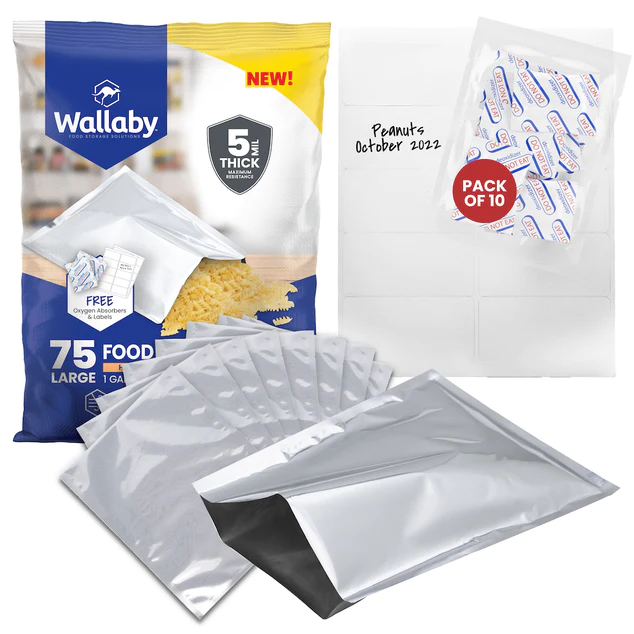White flour can last for 15+ years without going bad, and whole-grain flour can last approximately 5-10 years.
However, if you want the flour to last, you must have the correct flour storage container. This means a container that keeps out moisture, oxygen, and pests.
Below are the best containers for flour storage, including bulk containers, smaller containers, and budget-friendly solutions.
If you are new to bulk storage, I recommend reading how to preserve flour for years.
Best Bulk Flour Storage Containers
Here are the best storage containers for flour, as recommended by preppers and serious bakers.
Mylar Bags – best for long-term flour storage
Mylar bags are considered the best way to store dry foods long-term. Once sealed, they do not let any air or moisture through. If you put an oxygen absorber in the Mylar bag, the flour will last 10-15 years.
Pros:
- Completely airtight
- Don’t let moisture or light through
- Affordable
- Come in many sizes
Cons:
- Need to be sealed
- Can’t see contents
- Have a learning curve
Buckets with Gamma Lids – best for bulk flour storage (rotate within 1-2 years)
Food-grade buckets are great for storing large amounts of flour: a 5-gallon bucket will hold approximately 25lbs of flour.
The key is making sure you get gamma lids for the buckets. The gamma lids create an airtight seal. These lids also make it much easier to open and close the buckets.
Over time though, the seal on the lids can dry out and crack, so this is only suitable for storage flour if you rotate through it.
Pros:
- Hold large amounts of flour
- Affordable
- Easy solution
Cons:
- Might not be able to rotate through the flour fast enough
- Seals aren’t reliably airtight
Wide Mouth Mason Jars with Two-Part Lids – Best for storing smaller amounts of flour (rotate regularly)
An easy flour storage solution is to pour the flour into glass mason jars. The ones with two-part lids create an airtight seal. Jars with gasket lids also work, but the seal isn’t as reliable as two-part lids.
You can even put oxygen absorbers in the jar, meaning you won’t have to freeze or microwave the flour first to kill pests.
I don’t like using glass for flour storage; it breaks too easily during disasters like earthquakes, tornadoes, hurricanes, etc. But it’s a suitable container for storing bulk flour that you use regularly.
Tip: If you don’t want to use oxygen absorbers, you can use the FoodSaver sealer kit to vacuum seal mason jars. You’ll just need to put a piece of paper (like a cupcake liner) on top, so the flour doesn’t get sucked up.
Pros:
- Airtight seal
- Won’t let moisture through
- Can see contents inside
- Come in many sizes
- Affordable solution
Cons:
- Glass can break
- Seal may fail over time
Vacuum Sealer Containers – Best for storing smaller amounts of whole-grain flour or specialty flours
It is not a good idea to store flour long-term in vacuum sealer bags (read mylar bags vs vacuum sealing).
However, vacuum sealer containers are a good solution for whole-grain flour. Like any plastic container with a good seal, the containers will protect the flour from air and moisture for at least a year or two.
Unlike regular containers, though, these can be vacuum-sealed to remove air. They won’t remove all oxygen as oxygen absorbers will, but reduce the amounts so food will last longer.
Because vacuum sealer containers are somewhat pricy, I wouldn’t bother storing white flour in them. However, it can help extend the shelf life of whole-grain flour. Unlike white flour, whole-grain flour has a lot of oils in them, which go rancid in the presence of oxygen.
The most popular brands are FoodSaver and Lasting Freshness.
Pros:
- Removes some oxygen
- Has a good seal
- Can tell if seal has broken
- Convenient sizes
Cons:
- Pricey containers
- Not suitable for bulk flour storage
- Some brands aren’t very reliable
- No large size containers available
Rubbermaid Totes – cheap solution for bulk flour storage in dry climates
A lot of preppers store their flour in Rubbermaid tote containers. The ones made from Plastics #1, 2, 4, and 5 are food safe.
Rubbermaid has even started listing which of their products are food safe. The Brute series is particularly good for food.
You won’t get an airtight seal on a Rubbermaid tote, though, which means insects, air, and moisture can get into your flour.
Here’s a solution: Put a large piece of plastic wrap over the top of the tote. Make sure the plastic wrap extends over the edges. Then put the lid on. It’s not perfect but should work well enough if you don’t live in a humid climate.
Pros:
- Cheap solution
- Come in many sizes
- Stackable
- Durable
Cons:
- No gasket on lid
- Seal isn’t airtight
IRIS USA Pet Food Container – cheap container on wheels
Many serious bakers use this container by IRIS USA to store flour. It is advertised for storing pet food but is also suitable for food: it’s BPA-free, food-safe polypropylene plastic. This type of plastic isn’t as sturdy as HDPE but better withstands high temperatures.
The lids on the IRIS containers have gaskets, so do a pretty good job of creating an airtight seal. It will keep pests out.
However, you can expect the container to leach some air and moisture into the flour over time. Thus, it’s best to use this for flour that you rotate through within 1-2 years. The 47-quart size will hold 50lbs of flour.
If you don’t care about wheels, plenty of brands make cheap plastic containers that have gasket lids. Some of the best ones are Cambro, Sterilite, and Winco.
Pros:
- Cheap
- On wheels
- Comes in many sizes
Cons:
- PP plastic is not very sturdy
- Will leach air and moisture eventually
FoodBrick Containers – stackable, sturdy containers
WaterBrick is one of our top picks for long-term water storage containers. The brand also makes food storage containers which are great for flour. They come in two sizes: 3.5 gallons and 1.6 gallons. The best thing is that these containers are stackable, so you save space.
FoodBricks are made from very sturdy HDPE plastic. The lid has a gasket to make it airtight.
Like with all rubber gaskets, there is a possibility that the seal could fail over time. You can use oxygen absorbers with the FoodBricks, but you’ll need to check the container at least once a year to make sure the lid still looks “sucked down.”
Pros:
- Very sturdy and break-resistant
- Airtight and moisture-proof
- Stackable
- Convenient size
- Wide mouth
Cons:
- Containers aren’t cheap
- Seals aren’t reliably airtight
Important: Preventing Flour Pests
Many people think that simply putting flour into a sealed container will prevent pests. They don’t realize that flour already has insect eggs in it (the FDA allows up to 75 or more insect fragments per 50 grams of flour).
If you let the flour sit long enough – regardless of the storage container – those eggs will hatch, and you’ll end up with an infestation in your flour.
As one prepper said,
“I have never kept flour for a long spell that they didn’t erupt in a full blown condominium of mites. I’ve never had trouble with weevils but every brand of flour I’ve bought and held for any length of time has given birth to mites. Even flour in sealed glass containers has done it.”
Before putting your flour in storage containers, you will need to take steps to kill these eggs. This can be done by:
- Freeze the flour for at least 3 days before storage. Let it thaw completely before putting it in containers.
- Microwaving the flour before storage.
- Using oxygen absorbers in airtight storage containers.
Of these methods, I recommend using oxygen absorbers. It is easy and also extends the shelf life of your flour.
For more, read:
Plastics Safe for Food
If using plastic storage containers for flour, make sure that you use food-safe plastic. Otherwise, the plastic can leach chemicals into the flour.
Below are food-safe plastics:
- High-Density Polyethylene (HDPE) – the best option
- Polypropylene (PP)
- Low-Density Polyethylene (LDPE)
- Polyethylene Terephthalate (PET or PETE)
Read more about which plastics are safe for food here.
https://www.reddit.com/r/preppers/comments/g220o5/flour_storage/
https://www.reddit.com/r/preppers/comments/sn8wt8/food_grade_containers/
https://www.fda.gov/food/ingredients-additives-gras-packaging-guidance-documents-regulatory-information/food-defect-levels-handbook
https://www.homesteadingtoday.com/threads/flour-storage.261167/









